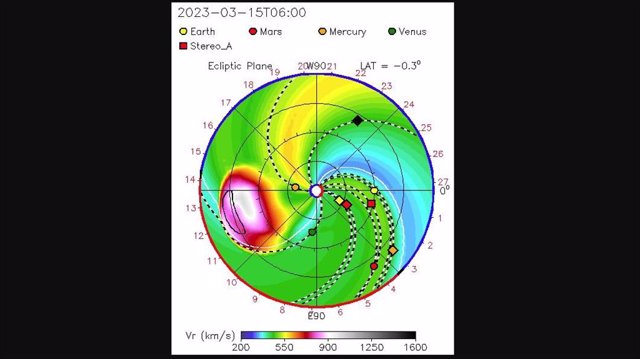March 14 () –
A massive eruption of solar material, known as a coronal mass ejection or CME, was detected escaping from the side of the Sun opposite Earth. at 17:36 UTC on March 12, 2023.
While the researchers are still collecting data to determine the source of the eruption, the CME is currently believed to have come from the ancient active region AR3234. This active region was on the Earth-facing side of the Sun from late February to early March.when he unleashed nine moderately intense M-class flares and one powerful X-class flare.
According to an analysis by NASA’s Moon to Mars Office of Space Weather, the CME was recorded to be traveling at an unusually fast speed of 2,127 kilometers per second, which earned him a speed-based rating of a CME of type R (rare).
A CME simulation shows the explosion rising from the Sun (located in the middle of the central white dot) and passing over Mercury (orange dot). Earth is a yellow circle located at the 3 o’clock position.
A circular diagram shows a swirl of colors. The Sun is depicted in the center and the planets and various spaceships are depicted around it. Suddenly, an explosion of darker colors moves away from the center point, representing the powerful CME moving at high speeds, reports NASA.
PROBABLE AFFECT TO THE PARKER SOLAR PROBE
The eruption likely struck NASA’s Parker Solar Probe head-on. The spacecraft is currently approaching its 15th closest approach to the Sun (or perihelion, flying 8.5 million kilometers) from the Sun on March 17. On March 13, the spacecraft sent out a green beacon tone that shows the spacecraft is in its nominal operating mode. Scientists and engineers are waiting for the next download of data from the spacecraftwhich will occur after close approach, for more information on this CME event and any potential impacts.
The eruption is known as a CME halo because it appears to spread evenly from the Sun in a halo, or ring, around the Sun.. Halo CMEs are dependent on the position of the observer and occur when the solar flare is aligned directly toward Earth or, as in this case, directly away from Earth.
This expanding ring is evident in the view from the NASA/ESA Solar and Heliospheric Observatory, or SOHO, spacecraft.
SOHO observes the Sun from a location approximately 1.5 million kilometers closer to the Sun along the Sun-Earth line. In the SOHO view, the Sun’s bright surface is blocked out to reveal the much thinner solar atmosphere and erupting solar material around it. The bright spot at the bottom right of the image is Mercury.
Although the CME erupted from the far side of the Sun, its impacts were felt on Earth. As CMEs streak through space, they create a shock wave that can accelerate particles along the CME’s path to incredible speeds, in the same way that an ocean wave pushes away surfers. Known as solar energetic particles, or SEPs, these speedy particles can make the 150 million kilometer journey from the Sun to Earth in around 30 minutes.
DETECTION ON OUR SIDE OF THE SUN
Although SEPs are commonly observed after solar flares facing Earth, they are less common for flares on the far side of the Sun. However, the Earth-orbiting spacecraft detected SEPs from the flare starting at midnight on March 12, which means that the CME it was powerful enough to trigger a wide cascade of collisions that made it all the way to our side of the Sun.











![[Img #74148]](https://thelatestnews.world/wp-content/uploads/2024/10/Street-lights-that-get-their-electricity-from-traffic-vibrations-300x200.jpg)
